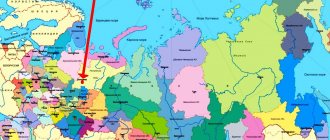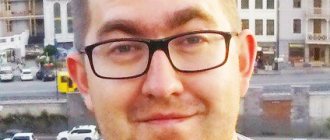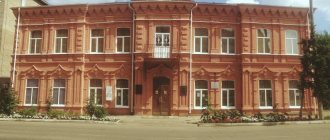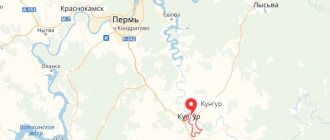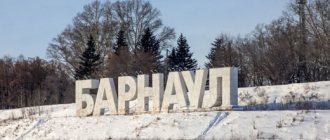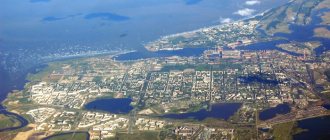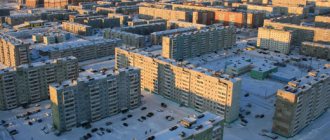Monument to dumplings
Who would have thought that there was such a miracle in the world. The dumplings monument really exists in Izhevsk. It was opened not so long ago - in October 2004. It is located near the Pozim cafe, which is located on the street. Kraeva. It consists of a huge fork on which a dumpling is placed. Its blunt end is stuck into the base of the monument. The dimensions of the original and unusual monument: one meter in diameter, height – exactly three meters.
The very story of how the dumpling monument in Izhevsk came into being is interesting. In general, the name of this meat dish comes from the Udmurt word “pelnyan”, which means “bread ear”, but in the Russian version it has changed slightly. The authors of the project were the Archeopteryx group. In their opinion, this place will not only attract tourists, but also attract newlyweds. Dumplings are a must-have dish for every wedding celebration in Udmurtia.
Historical landmark
Among the popular sites visited by tourists, the Friendship of Peoples Monument (Izhevsk) occupies an important place. Its history begins with Brezhnev times. The monument is considered the embodiment of democracy.
Stella seems like a half-open book, from the pages of which the voice of the people is heard. Indeed, if you read the inscriptions made in both Russian and Udmurt languages, you can learn a lot about the constant struggle of the working class against the oppressors.
It is noteworthy that the Georgian sculptor V. Topuridze, who previously specialized in monuments to V.I. Lenin, embodied the idea of friendship in stone. His most global work was the Monument to Friendship of Peoples in Izhevsk. The history of the monument has given rise to the belief that it helps to get an answer to an important question if you ask it while facing the pylons.
Monument to the crocodile
Another masterpiece is no less interesting. This is a monument to a crocodile in Izhevsk. It was installed recently - in 2005, and is located at the intersection of Kommunarov and Sovetskaya streets. It was invented by student Asen Safiullin, who studied at the Institute of Arts. The organizers of the project were the city administration, Elektromash and Gallery.
A city competition was announced for the best model of the future monument. At the same time, the following requirements were put forward: humor and irony. The monument to the crocodile in Izhevsk had to have a connection with both the present and the past of the city. Over 20 sculptors tried their hand at this original competition. And Asen won. The sculpture was created by the hands of Pavel Medvedev.
The monument was smelted from cast iron at the factory. Many changes were made to the original layout. As a result, the crocodile is sitting on a bench, wearing a top hat on his head and a bow tie around his neck. The monument has become a symbol of independence and freedom.
Curious facts
Initially, it was planned to install a stele 52 meters high and with four pylons. But according to safety requirements, signal lights must be installed on all structures over 50 meters. In this case, the Monument to Friendship of Peoples (Izhevsk) would not look so grandiose.
Therefore, the height had to be reduced and one of the sculptures removed. In addition, the monument should have been decorated with a mosaic painting. The draft drawing was even approved at the highest level, in Moscow. But funds were not allocated for all the ideas.
The monument in the Udmurt Republic, along with the Volgograd Mamayev Kurgan, was nominated for the “Seven Wonders of Russia” competition. In addition, his image is used in emblems to celebrate the Day of the City of Izhevsk and the anniversary of Udmurtia joining the ranks of Russia.
Gunsmiths, captured for centuries
There are more understandable and classic monuments in the city. The Izhevsk plant, created by decree of Alexander I, still produces weapons. And the monument to gunsmiths in Izhevsk is a tribute to the people who, over the years, glorified the enterprise throughout the country. Their work for the benefit of Russia will never be forgotten by their descendants. It was at this plant that Kalashnikov assault rifles, Bisons, the modern Abakan and many other types of weapons were produced.
For the monument, images were taken from old photographs. It represents common people and is a symbol of gunsmiths. It was opened in 2007. It is located right in front of the factory museum. The monument is made in the form of two figures dressed in caftans and top hats. It reaches a height of 2.7 meters, and if measured together with the pedestal, then 4 m. This sculpture weighs about four tons. The names of famous factory craftsmen are immortalized on it.
Brief description of Izhevsk
Izhevsk is a large populated city in Russia, the capital of Udmurtia and the center of the urban district of the same name. Izhevsk is 20th in Russia in terms of population (about 650 thousand people) with an area of 315 km2. Izhevsk is called the weapons capital of the Russian Federation, and in 2010 the city took 3rd place in the competition “The most comfortable city in Russia.” The capital of Udmurtia is located in the center of the republic, between the Vyatka and Kama rivers, on the Izh River.
Izhevsk is located at a distance of 1198 km from Moscow, 390 km from Kazan, 341 km from Ufa, 561 km from Samara and 200 km from Naberezhnye Chelny
City `s history
The territory of modern Izhevsk was first inhabited in the first centuries of our era. This is evidenced by archaeological finds - the remains of two ancient settlements. In the Middle Ages, Izhevsk became part of the Kazan Khanate, but in 1552 Kazan was captured by Russian troops, and the Khanate collapsed. In 1558, the Udmurt region became part of the Russian state. Almost 30 years later, Ivan IV donated this land to the Tatar Khan Bagish Yaushev, who formed the Tersinsky volost on the banks of the Izh. After 250 years, the Yaushev family sold their possessions to A.I. Tevkelev (Tatar by birth). A strong impetus to the development of the city was the construction of an ironworks (second half of the 18th century). The city was given capital status in 1934. This contributed to the further expansion of the city, the construction of new facilities and an increase in population.
Over the years, the Udmurt capital was called Izhevsk plant, Ustinov, Izhev, Ozhzavod, etc. The modern name comes from the river. True, some local historians and historians argue about the very name of the river. It is surprising that the stem “Izh” is used in several nationalities and in different settlements of the Volga region. For example, a tributary of the Izh is Pizhma, and there are also the rivers Varyzh and Izhma. There are also the villages of Izh and Izhevskoye.
Four ways to get to Izhevsk
Main ways to get to the city:
- By plane from Moscow, Saransk, St. Petersburg, Krasnodar, Tomsk, Sochi and other large cities. You can fly to Naberezhnye Chelny, and then take a taxi to Izhevsk.
- By train from Naberezhnye Chelny, Moscow, Kazan, Sochi, Kirov, Adler, Kislovodsk, Novorossiysk, etc.
- By bus. A convenient way to get there from nearby cities (Alnashi, Vavozh, Votkinsk, Glazov, etc.).
- By car via Naberezhnye Chelny, Kirov, Perm or Ufa.
The large federal highway M7 passes through Izhevsk; the most convenient way to get there is along it
The original monument to Zvezdochka
Izhevsk is also known for its monuments created in honor of animals. The monument to Zvezdochka was opened in the city in 2006. The author of the project was the famous sculptor of Izhevsk - Pavel Medvedev. As many remember, there were dogs on board one of the first Soviet spacecraft. One of them was Zvezdochka. Our heroine went into space in 1961. On the same day, the ship returned, landing in the Udmurtia region. Pilot Lev Okkelman found him and brought the dog to the airport. She lived there until she was taken to the capital.
This dog became the last flight tester. After her, the first man was sent into space. The monument looks as if a mongrel is peeking out of a ship's hatch. A lot of information is written on the surface of the monument, which is accessible not only to the sighted, but also to the blind. Some inscriptions are engraved in a special font for the blind.
The idea belonged to Sergei Pakhomov. Together with schoolchildren, they sculpted a ship and a dog out of snow. After this, the children wanted to erect a real monument to the astronaut. The sculptor was inspired by this idea. And soon the monument was ready.
Izhevsk
Video: Izhevsk
Basic moments
Izhevsk from a bird's eye view
Izhevsk stands between the Kama and Vyatka, on the Izh River, which divides it into two parts. The city is located 1200 km from Moscow and lives according to Samara time. The day comes here an hour earlier than in the capital of Russia. Streets and houses were built on a hilly plain, and the features of the relief were reflected in the old names of Izhevsk districts and streets - Gorka, Malinovaya Gora, Nagorny and Zareka. The highest place of the Udmurt capital is in the Eastern village (208 m), and the southern part of the urban area lies in the lowlands.
The historical center of Izhevsk was formed around former state-owned factories. You can come here by different types of public transport, but the most convenient way to do this is by tram number 11. The main architectural monuments and museums of the city are associated with the production of small arms. This is a monument to Izhevsk gunsmiths, a museum of the history of OJSC Izhmash, as well as a museum and exhibition complex of small arms, which bears the name of Mikhail Timofeevich Kalashnikov.
Monument to Izhevsk gunsmiths
Monument to Peoples' Friendship
The city has many beautiful temples, unusual monuments, interesting museums and pleasant green areas for walking. Tourists who come here try to take away weapons-themed souvenirs as a souvenir of their stay in Izhevsk. Patterned woolen socks and mittens, dolls in national Udmurt costumes and paintings by local artists are also popular among travelers.
Lenin Street in Izhevsk
Tower of the Main Building of Izhevsk)
East Street
Likhvintseva Street
Gorkogo Street
History of Izhevsk
The first settlements on the site where the arms capital of Russia later grew appeared in the 3rd-5th centuries. These were fortified settlements typical of the early Middle Ages, in which houses were protected from the enemy by earthen ditches, ramparts and high log walls. In addition, archaeologists discovered several burials on the territory of the city dating back to the 5th-6th centuries.
In the Middle Ages it was part of the powerful Kazan Khanate, and after the fall of Kazan the Udmurts joined Russia (1558). Then the lands on both banks of the Izh River, by decree of Ivan the Terrible, began to belong to the Tatar princely family of the Yaushevs.
Gunsmiths of the Izhevsk plant. 1880s
In the 1730s, rich deposits of iron ore were discovered on the right bank of the Kushva River, and several state-owned factories appeared for its extraction and processing. The deposits turned out to be so rich that the built capacities were clearly not enough.
The Russian Empress Elizaveta Petrovna ordered the opening of three more factories in the Kama region. Thus, thanks to the development of metallurgical production, the Izhevsk ironworks and the adjacent settlement were founded in 1760. Three years later, a dam was built on the river, and a large Izhevsky pond appeared.
At the same time, the first metal was produced at the plant. Local steel was obtained by melting cast iron, which was brought from other factories near the Urals. At first, bars and strips were made in Izhevsk, and then they began to cast iron gratings and anchors.
Bazarnaya Street (now Gorky Street), 1918
In 1774, the plant suffered great damage from the Pugachev uprising. Emelyan Pugachev's associates captured the village, executed the management and ruined the production. When the popular uprising was suppressed, the plant was restored.
At the beginning of the 19th century, firearms and bladed weapons began to be produced here. To help in mastering new technologies, many specialists from Germany, Sweden and Denmark came to the plant, and along with Izhevsk workers, craftsmen from other Russian arms factories worked in the workshops. In addition to weapons, the city mastered the production of tools, and at the end of the 19th century, steel foundry and rolling production appeared here. The plant began to fulfill not only military orders, but also made hunting rifles.
In 1934, the city became the capital of Udmurtia, and the change in status greatly affected its development. Over several decades, the population of Izhevsk has grown 10 times. The city quickly developed and expanded to include the surrounding villages.
Supreme Court of the Udmurt Republic
Residence of the Head of the Udmurt Republic
Sights of Izhevsk
In the city center, at 222 Karl Marx Street, stands the majestic Cathedral of the Archangel Michael. The beautiful red and white temple was built in 1907. During the years of Soviet power it was destroyed, and in 2006 it was restored by the decision of the townspeople. The temple rises to a height of 67 m. It stands on a hill, which offers excellent views of different areas of Izhevsk. And next to the cathedral is the picturesque Church of the Kazan Icon of the Mother of God.
Izhevsk at night
At the busy intersection of Udmurtskaya and Troitskaya streets you can see another cathedral - the Holy Trinity. The Orthodox church was erected in 1812-1814 on the site of a dilapidated wooden church. Today this cathedral is active.
Izhevsk Alexander Nevsky Cathedral (M. Gorky St., 86) has the status of a cathedral church. The temple in the style of Russian classicism was built in 1823 according to the design of the factory architect S. E. Dudin. A year later, the cathedral was visited by Russian Emperor Alexander I, who donated money for its construction. For a long time, the cathedral served as the urban center of Izhevsk and forms a harmonious architectural ensemble with the main building of the arms factory.
10 km from the Udmurt capital, in the village of Ludorvai, there is an ethnographic museum-reserve, occupying an area of 40 hectares. People come here to get acquainted with the life and culture of the indigenous people of the republic. There are many authentic buildings in the reserve - houses, estates and windmills, and folk craft master classes are held here for guests. Travelers who come to Ludorvai can ride a horse, go to a Russian bathhouse and taste national Udmurt dishes. The reserve is open to visitors on weekdays: from October to April from 11.00 to 15.00, from May to September from 10.00 to 18.00.
Sculpture of the wolf Akela at the entrance to the Izhevsk Zoo
Those who are tired of the city noise should take a walk along the picturesque embankment of Izhevsky Pond or along the Central Square, which is located near the Eternal Flame. A quiet park area is also located on Militsionnaya Street, on the shore of Izhevsky Pond. This is the spacious Summer Garden of Maxim Gorky, created back in 1857. Today, the Summer Garden has become an excellent city park with walking paths, shady alleys, fountains, cozy cafes and attractions for children.
Travelers with children love to stop by the Izhevsk Zoo (Kirova St., 8). All tourists who have visited here note its clean and well-groomed territory. The creators of the zoo not only comfortably accommodated the animals, but also created for them an environment that was as close as possible to their natural habitat. Today the zoo houses about 400 animals. It is open every day except Monday: in summer from 10.00 to 19.00, and in winter from 10.00 to 16.00.
Philadelphia Church
The old building of the Izhevsk Cathedral Mosque
Museums
On Borodina Street, 19, there is an interesting museum and exhibition complex named after M. T. Kalashnikov. This is one of the most visited museums in the city, attracting many tourists all year round. They can look at unique samples of weapons and documents telling about the Kalashnikov family, and also shoot with a machine gun at the shooting range. The museum is open to visitors from 11.00 to 19.00, and on weekends – until 17.00.
Another “weapons” museum is located on Sverdlova Street, 32. It reveals the history of the Izhevsk Armory). The exhibition displays samples of weapons and equipment that were made in the past and continue to be produced at this enterprise today.
To better learn about the traditions of the Udmurts, as well as how Izhevsk was built, it is worth taking a look at the National Museum of the Udmurt Republic. Its exhibitions occupy the large and beautiful Arsenal building at 287 Kommunarov Street, which has the status of an architectural monument of the 19th century. The museum is named after the poet Kuzebay Gerd. In its halls you can see bladed weapons and firearms, national Udmurt costumes, peasant household items, rare photographs and documents. The museum is open to visitors on all days except Monday: from Tuesday to Sunday from 10.00 to 18.00, and on Thursdays from 13.00 to 21.00.
The work of the republic's artists is presented in the Museum of Fine Arts (Kirova St., 128). Its halls contain 11 thousand exhibits - paintings, graphic works and sculptures. The museum welcomes visitors on all days except Sunday and Monday, from 10.00 to 18.00.
In the old school building, built in 1810, a center for arts and crafts and crafts was opened (V. Sivkov St., 173). This is an ethnographic and artistic exhibition where a variety of products of Udmurt craftsmen are exhibited - ceramics, as well as products made of wood, straw, glass and metal. It is noteworthy that here you can not only look at crafts, but also buy the works you like.
Unusual monuments
Izhevsk is famous for its unusual monuments. On the spacious Gunsmith Square stands the St. Michael's Column. The monument was erected in honor of the younger brother of the Russian Emperor Alexander I, Mikhail Pavlovich Romanov, who headed the Artillery Department and oversaw the work of the arms factory in Izhevsk.
Since 2010, on the edge of the Central Square, Izhik, a favorite of townspeople and tourists, has been installed - a little man in a gunsmith’s caftan. He is considered one of the symbols of the city, and there is a tradition of rubbing Izhik’s nose “for good luck.” It is not difficult to guess that the shiny metal nose is visible from afar.
At the intersection of Kommunarov and Sovetskaya streets there is a cast-iron allegory monument made in the postmodern style. A human-like crocodile sits imposingly on a cast-iron bench. Before the revolution of 1917, the artisans of the Izhevsk arms factory received the title of “kaftan workers.” At the same time, they were awarded a high top hat and a long-skirted caftan made of green cloth. And from the townspeople, Izhevsk artisans received the nickname “crocodiles.”
Goat monument
In the Birch Grove Park there is a monument to a goat, and therefore the park is often called “Goat Park”. About 100 years ago, there were private houses near the green area, and residents grazed goats next to them. The goat monument was built in steampunk style, using about 150 kg of scrap metal.
In March 1961, a Soviet spaceship landed in the steppes of Udmurtia, carrying the dog Zvezdochka. The animal's successful return to Earth marked a milestone for Yuri Gagarin's space flight, and as such Zvezdochka is considered a local celebrity. In the Zvezdochka park you can see a monument to the astronaut dog.
Residents of Izhevsk expressed their love for dumplings in a monument located near the Pozim cafe on Kraeva Street. A giant dumpling is impaled on a huge fork 3 meters high. It is curious that, according to one version, the word “dumpling” came into use from the Udmurt language: “pelnyan” translated means “bread ear”.
Sculpture "Dumpling"
Crocodile sculpture
Hotel deals
Booking.com
How to get there
You can fly to the weapons capital of Russia by plane. Izhevsk Airport is located 15 km east of the city center and is connected by direct flights to several Russian cities: Moscow, St. Petersburg, Sochi, Nizhny Novgorod, Kirov, Yekaterinburg, Ufa, Kazan, Anapa and Simferopol. You can get from the airport to the city by buses and taxis.
The city railway station is located at 16 Druzhby Street. About 100 trains come here every day. You can get from Moscow to Izhevsk by rail in 17 hours. From the station you can get to different parts of the city by trams, buses, minibuses and taxis.
If you wish, it is easy to come to Izhevsk by car. The road from Moscow takes about 17 hours (1200 km).
There are regular buses from some cities to Izhevsk. The capital of Udmurtia has daily bus service with Kazan, Perm, Ufa, Yekaterinburg, Naberezhnye Chelny, Nizhny Novgorod, Ulyanovsk and Yoshkar-Ola. The duration of the trip depends on the distance. On average, passengers spend 5-9 hours on the road and arrive at the central bus station of Izhevsk (Krasnoarmeyskaya St., 134).
Calendar of low prices for air tickets to Izhevsk
Famous monuments of Izhevsk
Among them, one bust standing on a pedestal is popular. This is a monument to Deryabin in Izhevsk. This man lived in pre-revolutionary times. He has a ribbon over his shoulder, and the Order of Anna hangs on his chest. Deryabin was one of the builders of the arms factory, and it was his work that allowed the city to become famous throughout the world.
This man left a big mark on the history of Russian industry and technology. He was born into the family of a priest and spent his childhood among mining prospectors. They excited his imagination with stories of countless treasures. Being impressed by them, Deryabin went to St. Petersburg to study at the mining school.
Over time, he visited many mines and factories in Germany, England and France. Traveling not only significantly expanded his horizons, but also contributed to the acquisition of invaluable knowledge and experience. This is what helped Deryabin’s promotion in his homeland. When it was decided to build a weapons factory, it was his project that was preferred.
St. Michael's pillar
Some monuments in Izhevsk are also dedicated to the dynasty that ruled Russia. For example, the sculpture, which was erected in honor of Grand Duke Mikhail Romanov, is the only monument in his honor in the entire country. The prince headed the Artillery Department. He was the highest commander of the Izhevsk arms factory. Not all monuments in the city of Izhevsk have retained their original appearance, and so it happened with this one. The sculpture - for obvious reasons - was demolished under Soviet rule, and it was restored only in 2007. The Mikhailovsky Pillar is located on the territory of the Izhmash Palace of Culture.
Monuments of the city of Izhevsk
Monument to Oberberghauptmann Andrei Fedorovich Deryabin, the founder of the Izhevsk arms factory.
Deryabin knew that the ironworks in the cities of Votkinsk and Izhevsk, founded by Demidov’s pioneers back in 1760, were perfectly suited for retraining for weapons production. There was already a clearly established system for the delivery of iron ore and charcoal. The local population quickly mastered the secrets of the craft. Thus, at the Izhevsk Plant, a village on the banks of the Izh River, a new weapons production was started. Already by the beginning of the military campaign against Napoleon, Izhevsk craftsmen supplied the Russian army with fuses, mortars, checkers and broadswords. Since that time, Izhevsk has been the largest forge of small arms for the country's defense. Erected on June 10, 1907 in honor of the founding father of the Izhevsk arms factory. The author of the monument is a self-taught artist and worker I. N. Sitnikov
Monument to military glory near the Eternal Flame
Opened in 1967, the authors of the monument are G.S. Ponomarev, R. Tagirov, sculptor - B.K. Volkov. At the same time, the Eternal Flame, which never goes out in any weather, was lit. The memorial is an undeniable symbol of the valor of the Russian army and the working people. The figure of a soldier (modeled, by the way, from a boy from the Udmurt village of Malaya Purga) rises menacingly above the flames with the Victory Banner in his hands. There is also a memorial plaque with engraved names of heroes of the Great Patriotic War.
On September 1, 2008, at the Izhevsk State Technical University, after a major reconstruction, the grand opening of the monument to the Eternal Student, which had stood here since the 1960s, took place
For almost half a century, the monument “Glory to Science” has stood near the second building of the Izhevsk State Technical University in the center of the campus. During this time, the monument acquired its second name - “Eternal Student”, the sympathy of Izhevsk residents and became a city monument, without which many generations of “mechanics” simply cannot imagine their native university. The second building of the Mechanical Institute took a very long time to build - eight years, and was commissioned only in 1962. The design of the building itself was carried out by the architect B. E. Chichkin. In accordance with the project and estimate, a sculpture was supposed to be in front of the building, and it was presented as an original work of art, made by the sculptor B.K., famous in the republic. Volkov Then he stood up to his full height in front of the “Eternal Student” building with a model of an atom in his hand. The sculpture of a student is ten years younger than the university itself. According to legend, the prototype for the sculpture was student A. Gubin (at that time chairman of the trade union committee), who had an athletic physique and enjoyed boundless authority among the freshmen. It was his figure that served the sculptor to embody the courageous, almost antique statue of the Eternal Student. For the face, a portrait of another person was used - V. Kosenko. In 1960, he was elected by students to the institute committee of the Komsomol.
St. Michael's Cathedral and the monument to Mikhail Timofeevich Kalashnikov at the entrance to his museum.
The author is sculptor V. Kurochkin. Vladimir Kurochkin is a graduate of the Moscow State Art Institute named after V.I. Surikov, Faculty of Sculpture, workshop of Professor A.I. Rukavishnikova; member of the Moscow Union of Artists; member of the Union of Artists of the Russian Federation.
Ironic sculpture
Monuments of the city of Izhevsk are also presented in several humorous copies. One of them is a sculpture of an ordinary goat. Its grand opening took place in 2006. They erected a monument in the Birch Grove, a well-known city park. The authors are Dmitry Postnikov and Alexander Suvorov.
This sculpture did not appear by chance, but as the personification of Izhevsk’s past. More than a century ago, the park where the monument was erected was a natural area where workers constantly came to rest after hard factory shifts. But urban construction did not stand still and was constantly expanding. As a result, private houses began to appear nearby, and residents grazed goats in the park. Animals ran around and were in full view of everyone. This place was even nicknamed “Goat Park”.
Similar sculptures
Despite the standard stele pattern for those times, there are only three similar monuments. They can be seen in the Bryansk region, Moscow and Ufa. Located in Izhevsk, it is the highest in Russia.
In Moscow, the monument is decorated in the form of the Russian and Georgian alphabet, which personifies the friendship of the peoples of these countries. The letters, upon closer examination, transform into the words “peace,” “friendship,” and “brotherhood.” The top of the sculpture is crowned with a gilded wreath.
In honor of the annexation of Bashkiria to Russia, a monument called “Friendship of Peoples” was also erected in Ufa. The Izhevsk version, however, is somewhat different in its airiness, and the proximity of the water surface gives it the appearance of a statue hovering over the lake.
In the Bryansk region, at the intersection of the borders of three countries - Russia, Belarus and Ukraine - an interesting monument was erected. It is made of white stone with a characteristic pattern and symbolizes the friendship of sister countries.
All three steles appeared thanks to the desire of people to embody in stone such an important thing as the friendship of peoples. The Izhevsk monument is the tallest, and city residents are proud of this fact.
Lenin
Monuments of Izhevsk include a monument to the great leader of the proletariat. It was originally a small bronze bust on a simple marble-painted wooden pedestal. It was built in 1926, after the death of the great leader. He was on the stairs that went down from Sovetskaya Street towards the dam.
It was supposed to lift the spirits of the workers who passed by it every day. But the wooden pedestal quickly deteriorated. As a result, a new monument appeared, only now in the form of a bronze statue. It was solemnly opened again on the day of the annexation of Udmurtia to Russia.
Children's entertainment in Izhevsk
The main attractions of Izhevsk may not impress a young tourist. In this case, you can visit the Izhevsk Circus and the city zoo.
State Circus of Udmurtia
The first circus groups in Izhevsk were groups of traveling performers. In the 19th century, a boardwalk performance area was built in the city, and the first permanent circus building was built in 1895. The design of the building was drawn up by A. G. Koromyslov. With the outbreak of the Civil War, devastation came to the city, and the circus building was destroyed. A new building (Kolart Circus) was built in 1926. After another 10 years, this building also fell into disrepair, so they began to build a stone building according to the design of P. M. Popov. Outwardly, it resembled the building of Gaetano Ciniselli's circus, but it was larger.
In 1990, the Izhevsk Circus was closed for reconstruction, but it soon became clear that the renovation would not be cheaper than the construction of a new building. Therefore, the old building was demolished, and in 2003 a new circus hospital was ready. This is the main circus of the republic, the technical conditions of which allow it to hold not only circus events, but also holidays of republican significance. In addition, the circus operates a circus school for children.
Information for tourists:
- address: Krasnoarmeyskaya street, 136;
- exact coordinates: 56°50′27″N 53°12′38″E;
- official website: https://udmcircus.ru;
- Opening hours: daily from 9:00 to 19:00;
- ticket prices depend on the program (prices for performances are listed on the website).
Video: giant fountain show at the Izhevsk Circus
Izhevsk Zoo
The State Zoo of Udmurtia is located in Izhevsk on an area of 16 hectares. It is considered one of the largest in the Volga region. The territory of the zoo is divided into several zones according to zoogeographical principles. The main zoological exhibitions are: “Far East”, “Our Taiga”, “White North” and “Udmurt Village”. Separately, you can look at the Monkey Country pavilion.
I was told that right at the entrance to the zoo you can see a statue in the form of a wolf. There is a legend associated with this sculpture that has become traditional: Izhevsk residents believe that touching the nose of a wolf leads to the fulfillment of a cherished dream. And, of course, you may not believe it, but something distinguishes this bronze statue from other monuments. The nose of this wolf was touched by the President of Udmurtia. After this, the statue became a separate landmark of Izhevsk.
Information for tourists:
- address: Kirova street, 8;
- official website: https://udm-zoo.ru;
- Opening hours: daily, except Mondays (from 10:00 to 20:00, in winter - until 16:00, in spring and autumn - until 18:00);
- entrance fee: up to 250 rubles.
Video: Zoo in Izhevsk
Other monuments
Several other works of art are also presented to tourists and guests of the city. For example, the Monument to Friendship of Peoples, which was opened in 1972. It was created in honor of the 4th anniversary, after Udmurtia joined Russia. Its height is 46 meters (about the size of a 16-story building). People often called it “Kulakova skis.” And this second name stuck to it after the Izhevsk skier was able to win three gold medals in Sapporo. There is an interesting legend: if you stand facing the monument and then ask yourself a question three times, the monument will definitely give the correct answer.
There is also a monument to Los in Izhevsk. And a number of sculptures that were installed after the Chernobyl accident. “Bird with Broken Wings” is also interesting, which was created as a memory of the victims of local conflicts. There is a cast statue of a steel worker right next to the plant. And the Wolf resides forever in the city zoo. If you visit the northern cemetery, you can see the WWII memorial there. And, of course, there is a monument to Pushkin in Izhevsk; a sculpture of the poet can be found in almost any city. It’s just done differently everywhere. And next to one of the city’s hairdressers there is an original monument “Scissors with a comb”.
Izhevsk is an interesting city with a rich history. Of course, every tourist should visit it. There is a lot to see here: historical and modern sculptures, architectural monuments, picturesque parks and squares. Guests of the city will leave here with beautiful and original photographs for their photo album.
One of the symbols of the city
A very remarkable place was chosen for the stele - on the square, near the Izhevsky pond. A stone staircase leads to it, decorated on all sides with flower beds.
The Monument to Friendship of Peoples (Izhevsk) consists of two pylons 46 meters high. Between them are relief gilded compositions depicting the life of a simple worker and peasant.
Many inhabitants of Udmurtia saw in the pylons of the stele a similarity with the image of some kind of sports equipment. Since residents are proud of the achievements of their fellow countrywoman Galina Kulakova, champion of various international cross-country skiing championships, the monument was nicknamed “Kulakova’s Skis.”
For the 450th anniversary of the republic’s annexation to Russia, the monument was transformed and reconstruction work was carried out. At night, the stele is brightly illuminated, which makes it even more attractive due to the glare of the water.
The symbol of the unification of working people of all nationalities is the People's Friendship Monument. Izhevsk is still not the only city where such standard projects exist.

